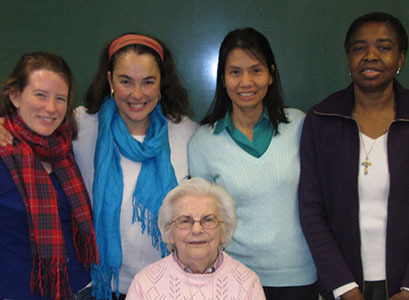Why I Study Women Religious
by Regina Siegfried, A.S.C.
 Regina Siegfried, A.S.C., seated, with students in her fall 2016 class: (left to right) Katherine Frazier, O.P.; Ana Gonzalez, O.P.; Cecilia Than, C.C.V.I.; and Margaret Uche, O.P.
Regina Siegfried, A.S.C., seated, with students in her fall 2016 class: (left to right) Katherine Frazier, O.P.; Ana Gonzalez, O.P.; Cecilia Than, C.C.V.I.; and Margaret Uche, O.P.
My adventure studying women religious began somewhere in the hazy mists of the late 1980s when I began teaching at Aquinas Institute of Theology in St. Louis, Missouri. The first course I taught was the theology of the vows. I quickly realized that the students also needed a companion class on the history of religious life in the United States to provide the context and background for that theology. My students didn’t understand the history of the role of women religious in the context of the broader Church. The early years of teaching the course involved scrambling to find suitable articles, since no text was yet available. Things are very different these days; writings from Mary Ewens, O.P., Peggy Thompson, Anne Butler, Carol Coburn, and Joe Chinnici, O.F.M., are valuable sources for background and information about the development of U.S. women religious. Even more recently, Maggie McGuinness’ Called To Serve is enriching reading.
My approach to teaching is chronological, beginning with background on the development of forms of religious life throughout history and concluding with post-Vatican II religious life in the United States. The pioneer spirit of 19th century congregations fascinates students. One of the most sobering and thought-provoking topics we discuss is that of communities and their slaves, since many students are unaware that congregations owned and sold slaves. I also devote a complementary class to the communities of African-American women, whose history needs much more highlighting.
Because many of my students’ first language is not English, I quickly learned that detailed study guides and questions for each assigned reading are necessary. Two practices that have captured students’ imaginations and creativity are community metaphors and congregational histories. After discussing Joe Chinnici’s “Rewriting the Master Narrative” (American Catholic Studies, Spring 2006), the students present a creative metaphor for their own congregation. Some of my students have imagined their congregation as a box of Crayolas, a loaf of bread, a symphony, and a pair of walking shoes. I encourage students to befriend their community archivist and give them directions about how to sniff around in archives to discover the secrets of the future. Their presentations on congregational history beam with pride, ownership, and loyalty. PowerPoint, video clips, music, and even period costumes enliven that class.
I continue to teach because I love the subject matter and enjoy watching how the students grow in appreciation of religious life as the semester progresses. Students learn to appreciate the charism, history, and ministries of other congregations. The aging and diminishment of congregations don’t lessen their hope for the future of religious life. Newer members are passionately devoted to their congregations, love their community members, and appreciate the value of inter-congregational formation programs that provide a network of peer friendships and communication. The LCWR and CMSM generation can serve as mentors, as seasoned members who help ground newer members in our traditions, charisms, and histories. We form bridges linking the past and present and future, connecting what has been and what is to what will be. Our newer members lead the way to a new growth. They fearlessly step where some might hesitate. None of us knows the future, but newer members are willing to lead our congregations in to new configurations, possibilities, and adventures. It is, therefore, important for them to know history, the texts and contexts of our congregations.
Regina Siegfried, A.S.C., Ph.D., is an adjunct instructor at the Aquinas Institute of Theology in St. Louis, where she teaches inter-community women novices. She also works in adult faith formation at St. Vincent De Paul parish in St. Louis.
This is one in a series of columns on this topic by CHWR members. If you’re interested in contributing, please contact chwr@chwr.org.